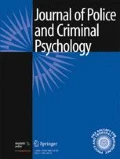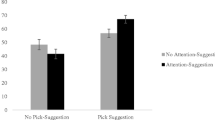Abstract
This study examined the effects of post-identification feedback on witness retrospective self-reports in showups and lineups, and importantly, focused on guilty and innocent suspect identifications. After viewing a mock crime video, participants were asked to identify the suspect from either a target-present or target-absent photo lineup or showup. Participants were randomly assigned to receive confirming feedback (“Great job, you made the correct decision”) or no feedback about their identification, before self-reporting confidence, view, attention, willingness to testify, and trust of a witness with a similar view. We replicated the typical finding that confirming feedback inflated witness self-reports and resulted in a larger proportion of witnesses meeting the credibility threshold necessary to testify. Importantly, we also found that showups had significantly higher self-reports than lineups, despite the equal discriminability achieved in this study between these two procedures. These data provide yet another reason for the police to restrict use of showups.

Similar content being viewed by others
Notes
It is important to note that this approach is not universal. Palmer et al. (2013) argued that removing filler identifications from analysis is removing the witnesses who have the poorest memories, and this could bias confidence-accuracy calibration curves (p. 62). However, we maintain that the applied utility of analyzing suspect IDs cannot be overstated (see also Mickes 2015), and that the legal system should care about what the self-reported judgments are for witnesses who choose suspects, because those are the individuals that progress to trial.
Note that this is different from the original feedback statement, “Good, you identified the suspect” (Wells and Bradfield 1998); a change made so that the feedback could apply to witnesses not selecting an individual from the lineup. Other studies have also changed the feedback (e.g., “you have been a really great witness”) and the feedback effects were not diminished (see Steblay et al. 2014 for a review).
References
Neil V Biggers (1972) 409 U.S. 188
Bradfield AL, Wells GL (2000) The perceived validity of eyewitness identification testimony: a test of the Five Biggers Criteria. Law Hum Behav 24:581–594
Manson V Brathwaite (1977) 432 U.S. 98
Charman SD, Carlucci M, Vallano J, Gregory AH (2010) The selective cue integration framework: a theory of postidentification witness confidence assessment. J Exp Psychol Appl 16:204–218
Clark SE (2012) Costs and benefits of eyewitness identification reform psychological science and public policy. Perspect Psychol Sci 7:238–259
Clark SE, Godfrey RD (2009) Eyewitness identification evidence and innocence risk. Psychon Bull Rev 16:22–42
Clark SE, Moreland MB, Gronlund SD (2014) Evolution of the empirical and theoretical foundations of eyewitness identification reform. Psychon Bull Rev 21:251–267
Clark SE, Benjamin AS, Wixted JT, Mickes L, Gronlund SD (2015) Eyewitness identification and the accuracy of the criminal justice system. Policy Insights from the Behavioral and Brain Sciences 2:175–186
Cutler BL, Penrod SD, Stuve TE (1988) Juror decision making in eyewitness identification cases. Law Hum Behav 12:41–55
Deffenbacher KA (1980) Eyewitness accuracy and confidence: can we infer anything about their relationship? Law Hum Behav 4:243–260
Douglass AB, Steblay N (2006) Memory distortion in eyewitnesses: a meta-analysis of the post-identification feedback effect. Appl Cogn Psychol 20:859–869
Dysart JE, Lindsay RCL (2007). Show-up identifications: suggestive technique or reliable method? In RCL Lindsay, DF Ross, JD Read, MP Toglia (Eds.) Handbook of eyewitness memory: memory for people, 2, 137–153.
Gronlund SD, Carlson CA, Neuschatz JS, Goodsell CA, Wetmore SA, Wooten A, Graham M (2012) Showups versus lineups: an evaluation using ROC analysis. Journal of Applied Research in Memory and Cognition 1:221–228
Gronlund SD, Wixted JT, Mickes L (2014) Evaluating eyewitness identification procedures using receiver operating characteristic analysis. Curr Dir Psychol Sci 23:3–10. doi:10.1177/0963721413498891
Juslin P, Olsson N, Winman A (1996) Calibration and diagnosticity of confidence in eyewitness identification: comments on what can be inferred from the low confidence–accuracy correlation. J Exp Psychol Learn Mem Cogn 22:1304. doi:10.1037/0278-7393.22.5.1304
Key KN, Cash DK, Neuschatz JS, Price JL, Wetmore SA, Gronlund SD, Goodsell CA (2015) Age differences (or lack thereof) in discriminability for lineups and showups. Psychol Crime Law 21:871–889. doi:10.1080/1068316X.2015.1054387
Leippe MR, Wells GL, Ostrom TM (1978) Crime seriousness as a determinant of accuracy in eyewitness identification. J Appl Psychol 63(3):345–351
Leippe MR, Eisenstadt D, Rauch SM (2009) Cueing confidence in eyewitness identifications: influence of biased lineup instructions and pre-identification memory feedback under varying lineup conditions. Law Hum Behav 33:194–212
Lindsey RCL (1994) Expectations of eyewitness performance: jurors’ verdicts do not follow from their belief. In: Ross DF, Read JD, Toglia MP (eds) Adult eyewitness testimony: current trends and developments. Cambridge University Press, New York, pp 182–200
Mickes L (2015) Receiver operating characteristic analysis and confidence–accuracy characteristic analysis in investigations of system variables and estimator variables that affect eyewitness memory. Journal of Applied Research in Memory and Cognition 4:93–102
Mickes L, Moreland MB, Clark SE, Wixted JT (2014) Missing the information needed to perform ROC analysis? Then compute d′, not the diagnosticity ratio. Journal of Applied Research in Memory and Cognition 3:58–62
Neuschatz JS, Preston EL, Burkett AD, Toglia MP, Lampinen JM, Neuschatz JS, Fairless AH, Lawson DS, Powers RA, Goodsell C (2005) The effects of post-identification feedback and age on retrospective eyewitness memory. Appl Cogn Psychol 19:435–453
Neuschatz JS, Wetmore SA, Key KN, Cash DK, Gronlund SD, Goodsell CA (2016) A comprehensive evaluation of showups. In: Bornstein B, Miller MK (eds) Advances in psychology and law, vol Vol 1. Springer International Publishing, Switzerland, pp 43–69
Palmer MA, Brewer N, Weber N, Nagesh A (2013) The confidence-accuracy relationship for eyewitness identification decisions: effects of exposure duration, retention interval, and divided attention. J Exp Psychol Appl 19:55–71
Pryke S, Lindsay RCL, Dysart JE, Dupuis P (2004) Multiple independent identification decisions: a method of calibrating eyewitness identifications. Journal of Applied Psychology 89:73–84
Quinlivan DS, Neuschatz JS, Douglass AB, Wells GL, Wetmore SA (2012) The effect of post-identification feedback, delay, and suspicion on accurate eyewitnesses. Law Hum Behav 36:206–214
Rotello CM, Chen T (2016) ROC curve analyses of eyewitness identification decisions: an analysis of the recent debate. Cognitive Research: Principles and Implications 1:10
Sporer SL, Penrod S, Read D, Cutler B (1995) Choosing, confidence, and accuracy: a meta-analysis of the confidence-accuracy relation in eyewitness identification studies. Psychol Bull 118:315–327. doi:10.1037/0033-2909.118.3.315
Steblay N, Dysart J, Fulero S, Lindsay RCL (2003) Eyewitness accuracy rates in police showup and lineup presentations: a meta-analytic comparison. Law Hum Behav 27:523–540. doi:10.1023/A:1025438223608
Steblay NK, Wells GL, Douglass AB (2014) The eyewitness post identification feedback effect 15 years later: theoretical and policy implications. Psychol Public Policy Law 20:1–18
Survey Monkey, Inc (2015). [online computer software]. Palo Alto, CA
Wells GL, Bradfield AL (1998) “Good, you identified the suspect”: feedback to eyewitnesses distorts their reports of the witnessing experience. J Appl Psychol 83:360–376
Wells GL, Bradfield AL (1999) Distortions in eyewitnesses’ recollections: can the post-identification feedback effect be moderated? Psychol Sci 10:138–144
Wells GL, Quinlivan DS (2009) Suggestive eyewitness procedures and the supreme Court’s reliability test in light of eyewitness science: 30 years later. Law Hum Behav 33:1–24. doi:10.1007/s10979-008-9130-3
Wells GL, Lindsay RCL, Ferguson TJ (1979) Accuracy, confidence, and juror perceptions in eyewitness identification. J Appl Psychol 64:440–448
Wells GL, Smalarz L, Smith AM (2015b) ROC analysis of lineups does not measure underlying discriminability and has limited value. Journal of Applied Research in Memory and Cognition 4:313–317. doi:10.1016/j.jarmac.2015.08.008
Wells GL, Smith AM, Smalarz L (2015a) ROC analysis of lineups obscures information that is critical for both theoretical understanding and applied purposes. Journal of Applied Research in Memory and Cognition 4:324–328. doi:10.1016/j.jarmac.2015.08.010
Wetmore SA, Neuschatz JS, Gronlund SD, Wooten A, Goodsell CA, Carlson CA (2015) Effect of retention interval on showup and lineup performance. Journal of Applied Research in Memory and Cognition 4:8–14
Wetmore SA, Gronlund SD, Neuschatz JS, Mcadoo RM (2016). Lineups are better than showups but filler siphoning is rarely the reason. Presented at the Annual Meeting of Psychonomics, Boston, MA
Wixted JT, Mickes L (2014) A signal-detection-based diagnostic-feature-detection model of eyewitness identification. Psychol Rev 121:262–276. doi:10.1037/a0035940
Wixted JT, Mickes L (2015a) Evaluating eyewitness identification procedures: ROC analysis and its misconceptions. Journal of Applied Research in Memory and Cognition 4:318–323
Wixted JT, Mickes L (2015b) ROC analysis measures objective discriminability for any eyewitness identification procedure. Journal of Applied Research in Memory and Cognition 4:329–334
Wixted JT, Mickes L, Clark SE, Gronlund SD, Roediger HL III (2015) Initial eyewitness confidence reliably predicts eyewitness identification accuracy. Am Psychol 70:515–526
Acknowledgments
The authors thank Amy Bradfield Douglass for providing insightful comments on an earlier version of the manuscript.
Author information
Authors and Affiliations
Corresponding author
Ethics declarations
All APA ethical guidelines were followed during the course of this study.
Rights and permissions
About this article
Cite this article
Key, K.N., Wetmore, S.A., Cash, D.K. et al. The Effect of Post-ID Feedback on Retrospective Self-Reports in Showups. J Police Crim Psych 32, 369–377 (2017). https://doi.org/10.1007/s11896-017-9228-y
Published:
Issue Date:
DOI: https://doi.org/10.1007/s11896-017-9228-y




